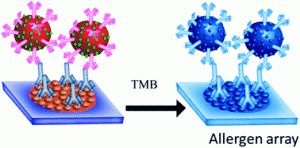Rece nt surveys from Allergy UK have shown that the rates of allergy are increasing throughout the world, affecting up to 30-35 % of people at some point during their lives, in some cases with fatal consequences. In vitro testing of specific Immunoglobin E (IgE) reactivities is thought to be able to significantly improve diagnostic accuracy and management in primary care. IgE plays a significant role in allergic conditions. Current methods for the sensitive and accurate detection of specific IgE reactivities are expensive; require significant sample preparation and investment in equipment. There is a need to provide a cheap, rapid, sensitive and specific test for IgE reactivities.
nt surveys from Allergy UK have shown that the rates of allergy are increasing throughout the world, affecting up to 30-35 % of people at some point during their lives, in some cases with fatal consequences. In vitro testing of specific Immunoglobin E (IgE) reactivities is thought to be able to significantly improve diagnostic accuracy and management in primary care. IgE plays a significant role in allergic conditions. Current methods for the sensitive and accurate detection of specific IgE reactivities are expensive; require significant sample preparation and investment in equipment. There is a need to provide a cheap, rapid, sensitive and specific test for IgE reactivities.
In a recent HOT article, a group of Swedish and Dutch Scientists describe a paper based lateral flow microarray for rapid allergy diagnostics. One of the authors, Jesper Gantelius of the Science for Life Laboratory, highlights “There is a rapid worldwide increase in atopic disorders and asthma without a clear understanding of the underlying cause. We have developed a paper-based microarray assay that could be used to rapidly and cost-efficiently evaluate a large number of specific IgE sensitisation’s in a primary care setting. The device may come to aid doctors in the personalised management of individual patients, as well as allow public health bodies to gain a better insight into the rapid increase of allergy-related conditions.”
The group, led by Prof. Helene Andersson Svahn, describe exciting research that was able to detect the responses of 15 specific IgE responses from 35 clinical serum samples with an inter-assay variability of 12 % revealing good general agreement with a current multiplexed array-based methodology. Interestingly this process is fully scalable and all that is required for data feedback is a consumer-grade flatbed scanner or smartphone camera enabling point-of-care diagnostics.
A lateral flow paper microarray for rapid allergy point of care diagnostics
Thiruppathiraja Chinnasamy, Loes I. Segerink, Mats Nystrand, Jesper Gantelius and Helene Andersson Svahn










